 |
PO Box 9021,
Wilmington, DE 19809, USA
E-mail: font@focusonnature.com
Phone: Toll-free in USA 1-800-721-9986
or 302/529-1876 |
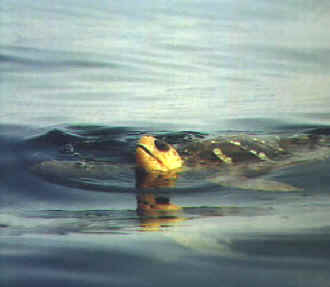 Amphibians
Amphibians
and Reptiles
of
Texas
Noting those during
Focus On Nature Tours
with an (*)
including:
Salamanders
Toads & Frogs (seen or heard)
Turtles
Skinks, Anoles, and other Lizards
Snakes
A List of Amphibians & Reptiles of
Texas
compiled by Armas Hill
UPPER RIGHT PHOTO: a LOGGERHEAD SEA TURTLE photographed during a FONT tour
(Photo by Alan Brady)
Codes:
C: in central Texas
E: in east Texas W: in west Texas
(ph): species with a photo in the FONT website
These classifications by the ICUN (international Union for Conservation of
Nature)
of Threatened & Near-threatened Species:
(t1) critically endangered
(t2) endangered
(t3) vulnerable
(nt) near-threatened
Excellent recordings of the sounds of frogs and toads are in the audio CD of "The
Calls of Frogs and Toads", by Lang Elliott, 2004.
In this list, numbers noted as (LE:xx) refer to
that of the particular frog or toad in the CD.
Recordings on the disk referred to here were by Lang Elliott, Carl Gerhardt, Ted
Mack, Bill Turcotte, and Tom Johnson.
Links to Groupings in this List:
AMPHIBIANS
Frogs & Toads Salamanders
REPTILES
Crocodile & Alligator Turtles Lizards
Snakes
Other Links:
Upcoming FONT Birding & Nature Tours in North America, including Texas
A
List & Photo Gallery of North American Birds, in 6 parts
A
List & Photo Gallery of Texas Birds, in 2 parts
Other Lists, with some photos, of Texas nature:
Mammals Butterflies
Dragonflies & Damselflies
Marine Life
(including fish,
corals, jellyfish, mollusks (shells), & arthropods: crustaceans & echinoderms)
A
Directory of Photos in this Website

Amphibians:
FROGS & TOADS
Family RANIDAE
- Bronze Frog ______
Rana clamitans clamitans
- American Bullfrog (ph) ______ (LE:1)
Rana catesbeiana
The American Bullfrog is heard in Texas from late winter to
autumn. It avoids temporary bodies of water.
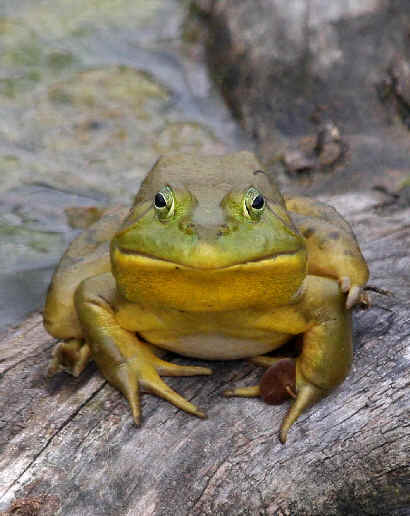
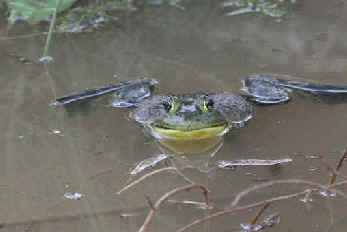
Two photographs of Bullfrogs
(upper photo courtesy of Doris Potter;
lower photo during a FONT tour)
- Pig Frog ______
(LE:2) in
far-eastern Texas
Rana grylio
The Pig Frog is usually heard in offshore vegetation, sometimes while
floating in the water. Large choruses produce a steady roar. Heard from
April to August.
- Pickerel Frog (ph) ______
(LE:11) in eastern Texas
Rana palustris
The Pickerel Frog breeds in lakes, ponds, streams, springs, and
in pools at entrances to caves. It also occurs grassy areas away from water.
Males sometimes call while submerged.

Pickerel Frog
(photo
by Marie Gardner)
- Southern Leopard Frog ______
(LE:9) in
eastern Texas
Rana sphenocephala
The Southern Leopard Frog often wanders away from water into
grassy and weedy places. It may be heard throughout the year in Texas.
- Plains Leopard Frog ______
(LE:8)
Rana blairi
- Rio Grande Leopard Frog ______
Rana berlandieri
- Crawfish Frog (*) ______
(LE:13)
Rana a. areolata
The Crawfish Frog favors moist prairies, pastures, and
meadows, where it takes shelter during the day in crawfish burrows, or the
burrows of other animals.
Family HYLIDAE
- Spring Peeper ______ (LE:23)
grows to about one and a half inches in length
Pseudacris crucifer
The Spring Peeper breeds in Texas from winter to spring, in
pools, ditches, and ponds. Not often seen outside the breeding season when
it looks for insects in trees and shrubs, and on the ground.
Pseudacris crucifer has a
"rain call" given periodically in the summer and autumn, from
trees and shrubs, that is a repeated series of peeps or squeaks that are
harsher and more dissonant than its call in the spring, hence the name "Autumn
Piper".
- Upland Chorus Frog ______
(LE:27) (subspecies of the Western Chorus Frog)
Pseudacris triseriata feriarum
- Spotted Chorus Frog ______
Pseudacris clarkii
- Strecker's Chorus Frog ______
(LE:25)
Pseudacris streckeri
The Strecker's Chorus Frog breeds in ponds, pools, and
ditches, from winter into spring, during or after rains.
- Green Treefrog ______
(LE:15)
Hyla cinerea
Other names for Hyla cinerea
are "Cowbell Frog" and "Rain Frog".
The first name is because at a distance the call can sound bell-like.
The second name is because huge choruses erupt after warm rains.
The Green Treefrog breeds in swamps, marshes, and
ponds.
- Squirrel Treefrog ______
(LE:18)
Hyla squirrela
The Squirrel Treefrog sometimes feeds in trees, but it
is also found on the ground near decaying stumps or logs.
It breeds in temporary ponds and ditches.
- Gray Treefrog ______
(LE:20)
Hyla versicolor
- Canyon Treefrog ______
Hyla arenicolor
- Mexican Treefrog ______
Smilisca baudinii
- Northern Cricket Frog ______
(LE:31) grows to about one and a half inches in
length
Acris crepitans crepitans
Acris crepitans blanchardi ______ Blanchard's Cricket
Frog .
The Northern Cricket Frog calls from open or grassy edges of
ponds, lakes, creeks, and swampy areas.
Family LEPTODACTYLIDAE
- White-lipped Frog ______
Leptodactylus labialis
- Eastern Barking Frog ______
Eleutherodactylus augusti latrans
- Cliff Chirping Frog ______
Syrrhophus marnockii
- Spotted Chirping Frog ______
Syrrhophus guttilatus
- Rio Grande Chirping Frog ______
Syrrhophus cystignathoides campi
Family BUFONIDAE
- (Dwarf) American Toad (ph) (*) ______
Bufo americanus charlesmithi

American Toad
(photo by Howard Eskin)
- Houston Toad ______
Bufo houstonensis
- Woodhouse's Toad ______
Bufo woodhousei
Bufo woodhousei australis Southwestern Woodhouse's
Toad ______
- Gulf Coast Toad (ph) ______
(LE:35) grows to about 5 inches in length
Bufo valliceps valliceps
The Gulf Coast Toad occurs in Central America and eastern Mexico
north into Texas, southern Louisiana, and southern Mississippi, with
isolated populations north into Arkansas.
It is found in variety of habitats from urban areas to coastal beaches and
prairies. It is the largest native toad in the US, but see the Giant Toad
(below, in this list).
The Gulf Coast Toad breeds in Texas from March through September in
ponds, lakes, and roadside ditches.
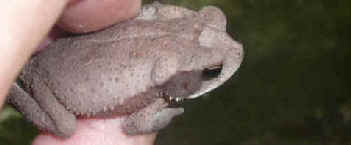
A Gulf Coast Toad during a FONT tour
(photo by Peter Mooney)
- Great Plains Toad ______
(LE:37)
Bufo cognatus
Bufo connatus
is the common toad of grasslands and dry prairie. It burrows for
protection from heat and dryness.
Its call can be from a great distance. At close range, it can deafening.
The Great Plains Toad breeds from spring into the summer in rivers,
ponds, ditches, and flooded areas.
- Texas Toad ______
Bufo speciosus
- Red-spotted Toad ______
Bufo punctatus
- Green Toad
Bufo debilis debilis Eastern Green Toad ______
Bufo debilis insidior Western Green Toad ______
- Giant Toad (or Marine Toad) ______
(not native to North America)
Bufo marinus
Bufo marinus occurs in extreme southern Texas. It can grow up
to 9 inches in length, or more.
Family PELOBATIDAE
- Hurter's Spadefoot Toad ______ (LE:39)
Scaphiopus hurterii
The Hurter's Spadefoot Toad was considered a subspecies of the Eastern
Spadefoot Toad, Scaphiopus holbrooki.
Scaphiopus hurterii occurs in
parts of Texas, Oklahoma, Louisiana, and Arkansas. It breeds in temporary
pools caused by heavy rains, and it can be heard in Texas anytime during the
year.
- Couch's Spadefoot Toad ______
Scaphiopus couchii
- Plains Spadefoot Toad
______ (LE:40)
Scaphiopus bombifrons
The Plains Spadefoot Toad is found mostly north of Texas, in
the Great Plains. Its primary advertisement call is a snore-like call,
repeated once every one to two seconds.
- New Mexico Spadefoot Toad ______
Scaphiopus multiplicatus
Family MICROHYLIDAE
- Eastern Narrowmouth Toad ______
(LE:41)
Gastrophryne carolinensis
The Eastern Narrowmouth Toad is found in variety of habitats, but
in its habits it is secretive.
It breeds in ponds, lakes, pools, and ditches.
- Great Plains Narrowmouth Toad ______
(LE:42)
Gastrophryne olivacea
The Great Plains Narrowmouth Toad hides beneath objects or in
burrows where it feeds on ants and other insects.
It breeds from spring to autumn after heavy rains.
- Sheep Frog ______
Hypopachus variolosus
SALAMANDERS
Family SIRENIDAE
- Lesser Siren ______
Siren intermedia nettingi Western Lesser
Siren ______ (in east Texas)
Siren intermedia texana Rio Grande Lesser
Siren ______ (in south Texas)
Family AMBYSTOMATIDAE
- Spotted Salamander ______
(in far-east Texas)
Ambystoma maculatum
- Marbled Salamander ______
(in far-east Texas)
Ambystoma opacum
- Mole Salamander ______ (in
far-east Texas)
Ambystoma talpoideum
- Tiger Salamander ______
Ambystoma tigrinum tigrinum Eastern Salamander ______
Ambystoma tigrinum mavortium Barred Tiger Salamander
______
Family PLETHODONTIDAE
- Southern Dusky Salamander ______
(in east Texas)
Desmognathus auriculatus
- Dwarf Salamander ______
(in east Texas)
Eurycea quadridigitata
- San Marcos Salamander ______
Eurycea nana
- Texas Salamander ______
Eurycea neotenes
- Comal Blind Salamander ______
Eurycea tridentifera
- Texas Blind Salamander ______
Typhlomolge rathbuni
- Blanco Blind Salamander ______
Typhlomolge robusta
- Western Slimy Salamander ______
Plethodon albagula
Family SALAMANDRIDAE
- Central Newt ______ (a
subspecies of the Red-spotted Newt)
Notophthalmus viridescens louisianensis
- Black-spotted Newt ______
Notophthalmus
meridionalis meridionalis
Reptiles:
ALLIGATOR
Family ALLIGATORIDAE
- American Alligator (ph) (*) ______
Alligator mississippiensis
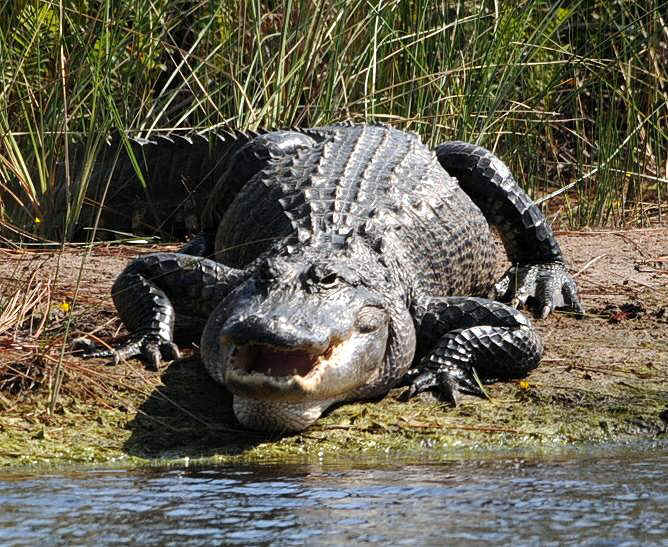
An American Alligator
(photo by Howard Eskin)
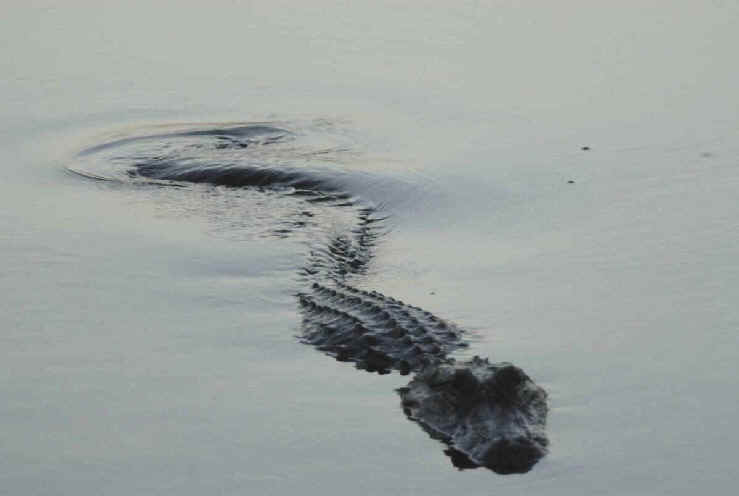
Two photographs of the American Alligator during a FONT Tour in Texas
(photos by Karl Frafjord)
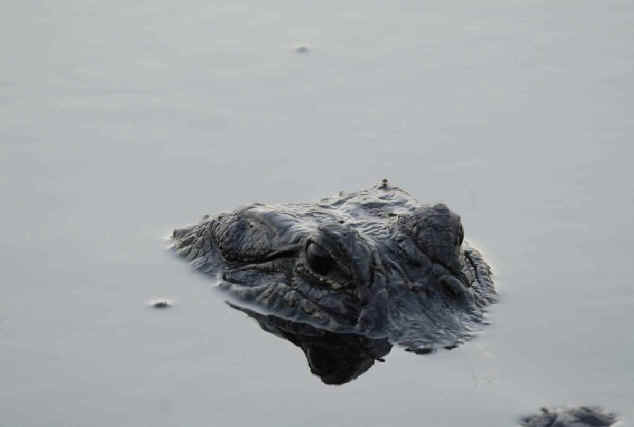
TURTLES
Family CHELYDRIDAE
- Snapping Turtle (ph) (*) ______
Chleydra serpentina
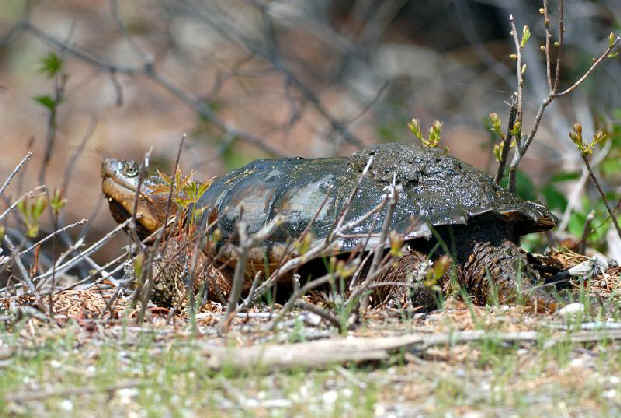
Snapping Turtle
(photo by Howard Eskin)
- Alligator Snapping Turtle
______ (in east Texas)
Macroclemys temminckii
Family KINOSTERNIDAE
- Mississippi Mud Turtle ______
Kinosternon subrubum hippocrepis
- Yellow Mud Turtle
______
Kinosternon
flavescens
- Big Bend Mud
Turtle ______
Kinosternon hiripes murrayi
- Eastern (or Common) Musk Turtle
(*) ______ (has been called
Stinkpot)
Sternotherus odoratus
- Razorbaack Musk Turtle ______
Sternotherus carinatus
- Stripeneck Musk Turtle ______
Sternotherus minor pelifer
Family EMYDIDAE
- River Cooter ______
Chrysemys concinna metteri Missouri River Cooter
______ (in east Texas)
Chrysemys concinna gorzugi Rio Grande River Cooter
______ (in south & west Texas)
- Texas River Cooter (ph) (*)
______
Pseudemys texana

Texas River Cooters photographed during a FONT tour in Texas
(photo by Karl Frafjord)
- (Three-toed) Box Turtle (ph) (*) ______
Terrapene carolina triunguis

Box Turtle
(photo by Howard Eskin)
- Ornate Box Turtle ______
Terrapene ornata ornata ______
Terrapene ornata luteola ______ (in west Texas)
- (Southern) Painted Turtle (ph) ______
(an isolated colony in central Texas)
Chrysemys picta dorsalis
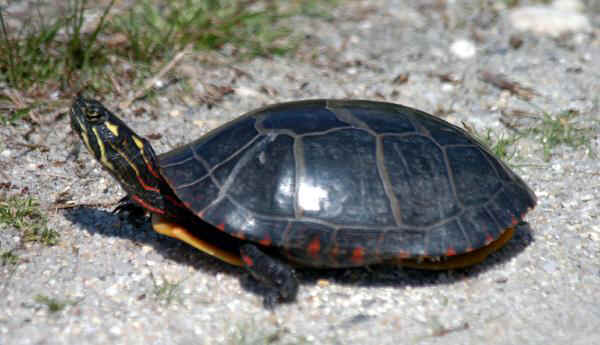
Painted Turtles
(photo by Howard Eskin)
- Red-eared Slider (ph) (*) ______
Trachemys scripta elegans
In Trachemys scripta, the reddish
stripe behind the eye is unique among North American turtles, but not all Red-ears
have it. Rarely the red is replaced by yellow.
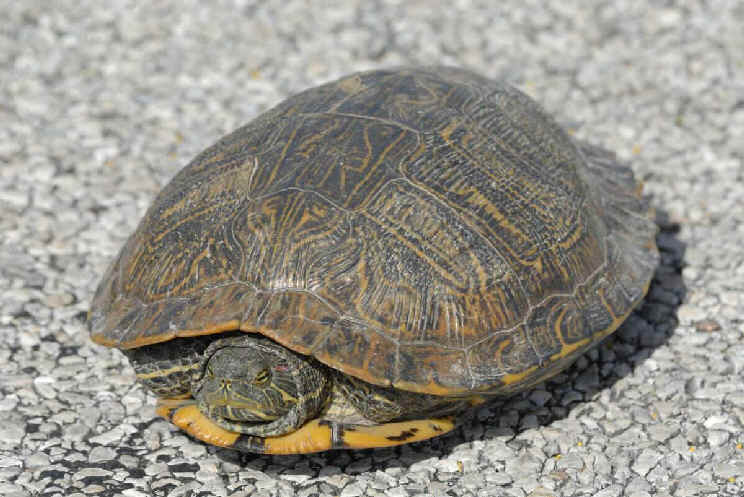
A Red-eared Slider photographed during a FONT Texas Tour.
This turtle was crossing a road west of Austin.
It's hard to see the red line behind the eye, but it's there.
(photo by Karl Frafjord)
- Big Bend Slider ______
Trachemys gaigeae
- Mississippi Map Turtle ______
Graptemys kohnii
- Sabine Map Turtle ______
(a
subspecies of the False Map Turtle) (in far-eastern Texas)
Graptemys pseudogeographica sabinensis
- Texas Map Turtle ______
Graptemys versa
- Cagle's Map Turtle ______
Graptemys caglei
- Western Chicken Turtle ______
Deirochelys reticularia miaria
- (Texas) Diamondback Terrapin (ph) (*) ______
Malaclemys terrapin littoralis
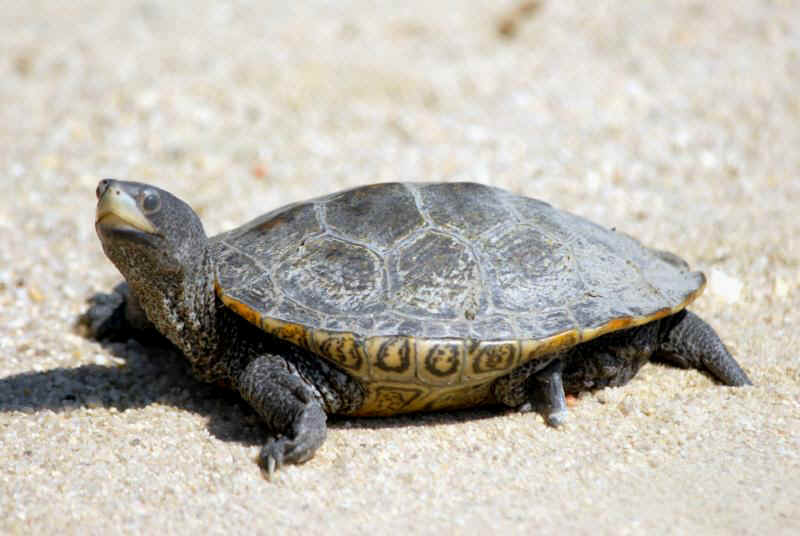
Diamondback Terrapin
(photo by Howard Eskin)
Family TESTUDINIDAE
- Texas Tortoise ______
Gopherus berlandieri
Families DERMOCHELYIDAE and CHELONIIDAE
An excellent book, filled with good information
about Sea Turtles, and interesting reading, is "Voyage of the
Turtle - in Pursuit of the Earth's Last Dinosaur", by Carl
Safina, published in 2007.
- Leatherback (Sea Turtle) (t1) (*) ______
(offshore in the Gulf of Mexico)
Dermochelys coriacea
- Loggerhead (Sea Turtle) (t2) (ph) (*) ______
(offshore in the Gulf of Mexico)
Caretta caretta

Loggerhead Sea Turtle
(photographed by Alan Brady during a FONT tour)
- Green (Sea) Turtle (t2) (ph) ______
(offshore in the Gulf of Mexico)
Chelonia mydas
- Atlantic Hawksbill (t1) ______
(offshore in the Gulf of Mexico)
Eretmochelys imbricata imbricata
- Kemp's Ridley (t1) ______
Lepidochelys kempii
The Kemp's Ridley is globally the most endangered of the sea
turtles, but it is the species most commonly found in the Texan waters of
the Gulf of Mexico.
The primary nesting area for the species is in the Mexican state of
Tampaulipas, where Rancho Nuevo has been the only known major nesting beach
for the species in the world.
A secondary nesting population has been established at the Padre Island
National Seashore in Texas.
Family TRIONYCHIDAE
- Midland Smooth Softshell ______
Apalone m. mutica
- Spiny Softshell (ph) (*) ______
Apalone spinifera pallida Pallid Spiny Softshell
______
Apalone spinifera emoryi Texas Spiny Softshell ______
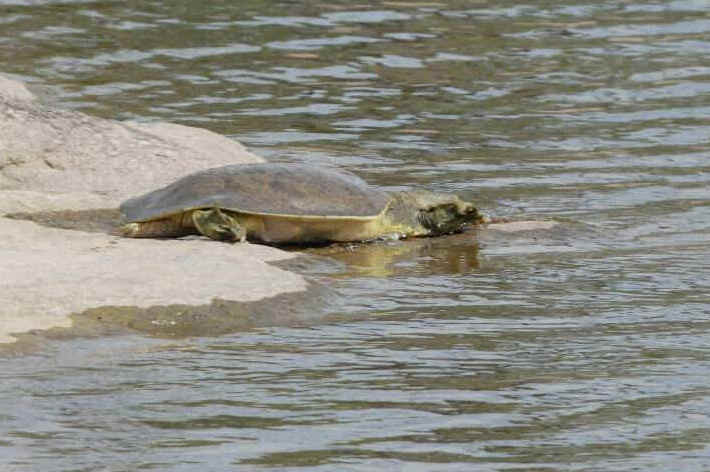
A Texas Spiny Softshell photographed during a FONT tour in Texas
(photo by Karl Frafjord)
LIZARDS
Family GEKKONIDAE and EUBLEPHARIDAE
- Roughtail Gecko (i) ______
Cyrtopodion scabrum
- Mediterranean Gecko (i) ______
Hemidactylus turcicus turcicus
Family POLYCHRIDAE
- Carolina Anole (*) ______
(has been called Green Anole)
Anolis carolinensis
Family IGUANIDAE
- Spinytail Iguana (i)
______
Ctenosaura pectinata
Family CROTAPHYTIDAE
- Collared Lizard ______
Crotaphytus collaris collaris Eastern Collared Lizard ______
Crotaphytus collaris baileyi Western Collared Lizard ______
Crotaphytus collaris fuscus Chihuahuan Collared Lizard
______
- Reticulate Collared Lizard ______
Crotaphytus reticulatus
- Longnose Leopard Lizard ______
Gambelia wislizenii wislizenii
Family PHRYNOSOMATIDAE
- Greater Earless Lizard ______
Cophosaurus t. texanus Texas Earless Lizard ______
Cophosaurus texanusscitulus Southwestern Earless Lizard
______ (in west Texas)
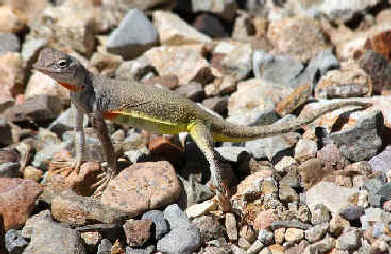
A Greater Earless Lizard photographed during a FONT
tour
- Earless Lizard ______
Holbrookia maculata maculata Northern Earless Lizard
______ (in north Texas)
Holbrookia maculata perspicus Eastern Earless Lizard ______
(in
north-central Texas)
Holbrookia maculata approximans Speckled Earless Lizard
______ (in west Texas)
- Spot-tailed Earless Lizard ______
Holbrookia lacerata subcaudalis Southern Earless Lizard ______
Holbrookia l. lacerata Plateau Earless Lizard ______
(northwestward from the Edwards Plateau)
- Keeled Earless Lizard ______
Holbrookia p. propinqua
- Rosebelly Lizard ______
Sceloporus variabilis marmotatus
- Mesquite Lizard ______
Sceloporus grammicus microlepidotus
- Crevice Spiny Lizard ______
Sceloporus poinsettii poinsettii
- Blue Spiny Lizard ______
Sceloporus serrifer cyanogenys
- Twin-spotted (or Desert) Spiny Lizard
______ (in west Texas)
Sceloporus magister bimaculosus
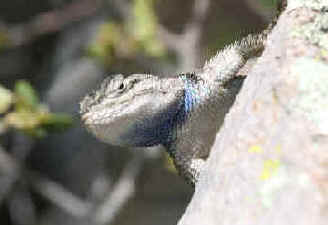
A Twin-spotted, or Desert Spiny Lizard during a FONT tour
- Texas Spiny Lizard ______
Sceloporus olivaceus
- Southern Prairie Lizard ______
(conspecific with the Eastern Fence Lizard)
Sceloporus undulatus consobrinus
Sceloporus undualtus garmani Northern Prairie Lizard
______ (in far-north Texas)
- Canyon Lizard ______ (in west
Texas)
Sceloporus merriami
- Tree Lizard ______
Urosaurus ornatus orantus Eastern Tree Lizard ______
Urosaurus ornatus schmidti Big Bend Tree Lizard ______
- Desert Side-blotched Lizard ______
Uta stansburiana stejnegeri
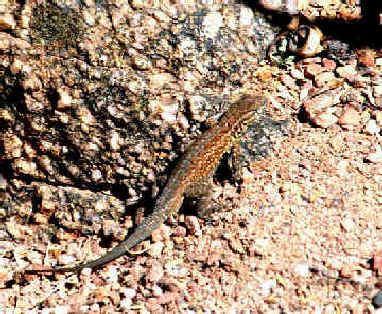
Desert Side-blotched Lizard
(photo by Howard Eskin)
- Texas Horned Lizard ______
Phrynosoma cornutum
- Mountain Short-horned Lizard ______
Phrynosoma douglassii hernandesi
- Roundtail Horned Lizard ______
Phrynosoma modestum
Family SCINCIDAE
- Five-lined Skink ______ (in
east Texas)
Eumeces fasciatus
- Broadhead Skink ______ (in east
Texas)
Eumeces laticeps
- Great Plains Skink ______
Eumeces obsoletus
- Four-lined Skink ______
Eumeces tetragrammus brevilineatus ______
Eumeces t. tetragrammus Four-lined Skink ______
(in
far-south Texas)
- Coal Skink ______ (in far-east
Texas)
Eumeces anthracinus
- Southern Prairie Skink
______
Eumeces septentrionalis obtusirostris
- Variable Skink ______
Eumeces multivirgatus epipleurotus
- Ground Skink ______
Scincella lateralis
Family TEIIDAE
- Prairie Six-lined Racerunner ______
Cnemidophorus sexlineatus viridis
- Chihuahuan Spotted Whiptail
______ (in west Texas)
Cnemidophorus exsanguis
- Laredo Striped Whiptail ______
Cnemidophorus laredoensis
- Texas Spotted Whiptail ______
Cnemidophorus g. gularis
- Trans-Pecos Striped Whiptail ______
Cnemidophorus inornatus heptagrammus
- New Mexico Whiptail ______
(in
far-west Texas)
Cnemidophorus neomexicanus
- Checkered Whiptail ______
Cnemidophorus tesselatus
- Plateau Spotted Whiptail ______
(in far-west Texas)
Cnemidophorus s. septemvittatus
- Marbled Whiptail ______ (in
west Texas)
Cnemidophorus marmoratus
Family ANGUIDAE
- Western Slender Glass Lizard ______
Ophisaurus a. attenuatus
- Texas Alligator Lizard ______
Gerrhonotus
liocephalus infernalis
SNAKES
Family LEPTOTYPHLOPIDAE
- Texas Blind Snake ______
Leptotyphlops dulcis
- Trans-Pecos Blind Snake ______
Leptotyphlops humilis segregus
Family COLUBRIDAE
- Mississippi Green Water Snake ______
Nerodia cyclopion
- Diamondback Water Snake ______
Nerodia r. rhombifer
- Plainbelly Water Snake ______
Nerodia erythrogaster flavigaster ______ (in east Texas)
Nerodia erythrogaster transversa Blotched Water
Snake ______
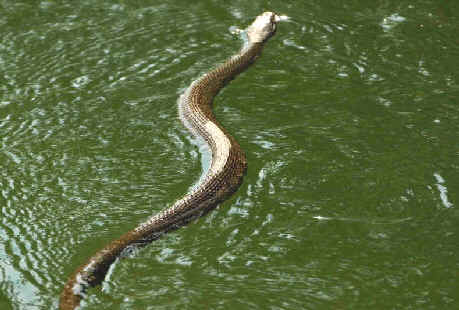
A Blotched Water Snake swimming across a small
river.
(photographed during a FONT Texas Tour in May 2010, by Karl Frafjord)
- Broad-banded Water Snake ______
Nerodia fasciata confluens
- Gulf Salt Marsh Snake ______
Nerodia clarkii clarkii
- Harter's Water Snake ______
Nerodia harteri
- Texas Scarlet Snake ______
Cemophora coccinea lineri
Cemophora coccinea copei Northern Scarlet Snake
______ (in east Texas)
- Texas Longnose Snake ______
Rhinocheilus lecontei
tessellatus
- Eastern Yellowbelly Racer (*) ______
Coluber constrictor flaviventris
Coluber constrictor oaxaca Mexican Racer ______
Coluber constrictor anthicus Buttermilk Racer
______
- Ringneck Snake ______
Diadophis punctatus arnyi Prairie Ringneck Snake
______
Diadophis punctatus regalis Regal Ringneck Snake
______
Diadophis punctatus stictogenys Mississippi Ringneck
Snake ______
- Great Plains Rat Snake ______ (conspecific
with the Corn Snake)
Elaphe guttata emoryi
- Black Rat Snake ______
Elaphe o. obseleta
Elaphe obseleta lindheimerii Texas Rat Snake ______
- Baird's Rat Snake
______
Elaphe bairdi
- Trans-Pecos Rat
Snake ______
Bogertophis subocularis
- Glossy Snake
______
Arizona elegans arenicola Texas Glossy Snake ______
Arizona e. elegans Kansas Glossy Snake ______
- Bullsnake
______
Pituophis melanoleucus sayi
Pituophis melanoleucus ruthveni Louisiana Pine Snake ______
Pituophis melanoleucus affinis Sonoran Gopher Snake ______
- Western Mud Snake ______
Farancia abacura reinwardtii
- Eastern Hognose Snake ______
Heterodon platyrhinos
- Western Hognose Snake ______
Heterodon nasicus
- Kingsnake ______
Lampropeltis getula hollbrooki Speckled
Kingsnake ______
Lampropeltis getula splendida Desert Kingsnake ______
- Prairie Kingsnake
______
Lampropeltis c. calligaster
- Gray-banded Kingsnake
______
Lampropeltis alterna
- Milk Snake ______
Lampropeltis triangulum annulata Mexican
Milk Snake ______
Lampropeltis triangulum amaura Louisiana Milk Snake ______
Lampropeltis triangulum celaenops New Mexico Milk Snake ______
- Coachwhip ______
Masticophis f. flagellum Eastern
Coachwhip ______
Masticophis flagellum testaceus Western Coachwhip
______
- Central Texas Coachwhip ______
Masticophis taeniatus girardi
Masticophis taeniatus schotti Schott's Coachwhip ______
Masticophis taeniatus ruthveni Ruthven's Whipsnake ______
- Rough Green Snake ______
Opheodrys aestivus
- Smooth Green Snake
______
Opheodrys vernalis
- Speckled Racer ______
Drymobius m.
margaritiferus

A Speckled Racer during a FONT Tour
- Texas Indigo Snake ______
Drymobius corais exebennus
- Patchnose Snake ______
Salvadora a. grahamiae Mountain Patchnose Snake ______
Salvadora grahamiae lineata Texas Patchnose Snake ______
- Big Bend Patchnose Snake ______
Salvadora deserticola
- Graham's Crayfish Snake ______
Regina grahamii
- Glossy Crayfish Snake ______
Regina rigida
- Brown Snake ______
Storeia dekayi texana Texas Brown Snake ______
Storeia dekayi limnetes Marsh Brown Snake ______
- Florida Redbelly Snake ______
(in east Texas)
Storeria occipitomaculata obscura
- Ground Snake ______
Sonora semiannulata
- Black-striped Snake ______ (in
far-south Texas)
Coniophanes i, imperialis
- Mexican Hooknose Snake ______ (in
south Texas)
Ficimia streckeri
- Western Hooknose Snake ______
(in west Texas)
Gyalopion canum
- Texas Night Snake ______
Hypsiglena torquata jani
- Northern Cat-eyed Snake ______ (in
south Texas)
Leptodeira s. septentrionalis
- Texas Lyre Snake ______
(in west Texas)
Trimorphodon bisentatus vilkinsonii
- Flathead Snake ______
Tantilla gracilis
- Plains Blackhead Snake ______
Tantilla nigriceps
- Southwestern Blackhead Snake ______
Tantilla hobartsmithi
- Mexican Blackhead Snake ______
(in south Texas)
Tantilla atriceps
- Devil's River Blackhead Snake ______
Tantilla rubra diabola
Tantilla rubra cucullata Blackhood Snake ______
(in west Texas)
- Garter Snake ______
Thamnophis s. sirtalis Eastern
Garter Snake ______
Thamnophis sirtalis annectens Texas Garter Snake
______


Two photographs of the Eastern Garter Snake
(above photo by Doris Potter; lower photo by Howard Eskin)
- Checkered Garter Snake ______
Thamnophis m. marcianus
- Blackneck Garter Snake ______
Thamnophis c. cyrtopsis Western Blackneck Garter Snake ______
Thamnophis cyrtopsis ocellatus Eastern Blackneck Garter Snake
______
- Ribbon Snake ______
Thamnophis p. proximus Western Ribbon Snake ______
Thamnophis proximus rubrilineatus Redstripe Ribbon
Snake ______
Thamnophis proximus orarius Gulf Coast Ribbon Snake
______
Thamnophis proximus diabolicus Arid Land Ribbon Snake
______
- Lined Snake ______
Tropidoclonion lineatum
- Rough Earth Snake ______
Virginia striatula
- Western Earth Snake ______
Virginia valeriae elegans
Family ELAPIDAE
- Texas Coral Snake ______
Micrurus fulvius tener
Family VIPERIDAE
- Copperhead ______ (venomous)
Agkistrodon c. contortrix Southern Copperhead
______ (in east Texas)
Agkistrodon contortrix laticinctus Broad-banded
Copperhead ______
Agkistrodon contortrix pictigaster Trans-Pecos
Copperhead ______ (in west Texas)
- Western Cottonmouth (ph) (*) ______
(venomous)
Agkistrodon piscivorus leucostma
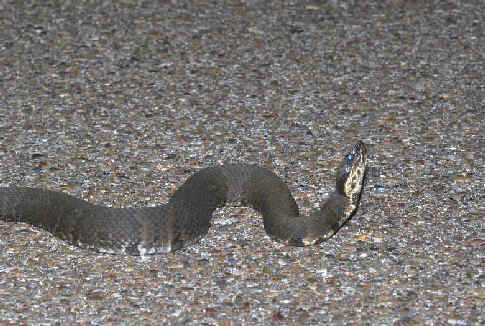
Western Cottonmouth
(photo during a FONT Texas Tour in May 2010 by Karl Frafjord)
- Massasauga ______
Sistrurus catenatus tergeninus Western Massasauga
______
Sistrurus catenatus edwardsii Desert Massasauga
______
- Western Diamondback Rattlesnake ______
(venomous)
Crotalus atrox
- Timber Rattlesnake (ph) _____
(in east Texas)
(venomous)
Crotalus horridus
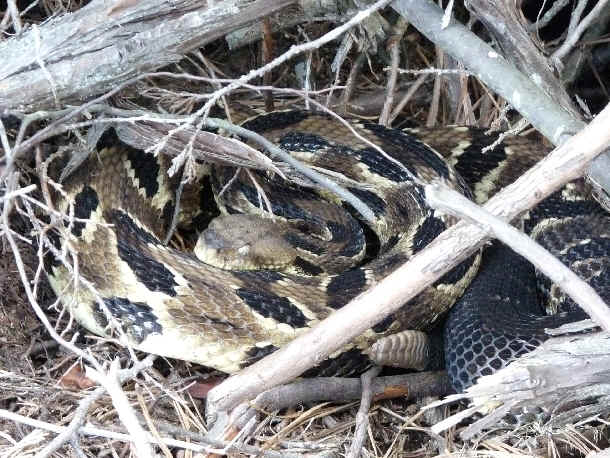
Timber Rattlesnake
(photo by Fred Lesser)
- Mojave Rattlesnake ______
(in
west Texas)
Crotalus s. scutulatus
- Prairie Rattlesnake ______ (in
north & west Texas)
Crotalus v. viridis
- Blacktail Rattlesnake ______
Crotalus m. molossus
- Mottled Rock Rattlesnake ______
Crotalus l. lepidus
Crotalus lepidus klauberi Banded Rock Rattlesnake ______
(a Mexican subspecies in far-west Texas)
- Western Pygmy Rattlesnake
______
(venomous)
Sistrurus miliarius streckeri
Some selected reference books regarding
Amphibians & Reptiles:
"Amphibians & Reptiles of the Carolinas
and Virginia", by Bernard Martof, William Palmer, Joseph Bailey, &
Julian Harrison III, with photographs by Jack Dermid, 1980


 Amphibians
Amphibians
























